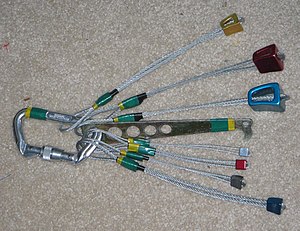Difference between revisions of "AY Honors/Rock Climbing/Answer Key"
(merge) |
|||
| (One intermediate revision by the same user not shown) | |||
| Line 1: | Line 1: | ||
| − | + | {{mergefrom|Chockstones}} | |
| − | + | [[Image:7nuts_and_tool_on_carabiner.jpeg|thumb|300px|A selection of nuts and a nut removal tool.]] | |
| − | + | In [[rock climbing]], a '''nut''' is a metal wedge threaded on a wire, used for [[protection (climbing)|protection]] by wedging it into a crack in the rock. Nuts come in a variety of sizes and styles, and several different brands are made by competing manufacturers. Most nuts are made out of [[aluminum]]. Larger nuts may be threaded on [[Dyneema|Dyneema]] cord instead of wire, but this has become unusual. Nuts are related to, but not interchangeable with, [[Climbing equipment|Hexcentrics]]. | |
| − | + | The very smallest nuts are known as ''micronuts'' and may be made of [[steel]], [[copper]], or an [[alloy]]. They typically have their wires [[solder]]ed into them, as opposed to looped through drilled holes in the nut. They are most commonly used in [[aid climbing]], and their value as protection (ie arresting a climbers' fall) is generally considered marginal due to their relatively low breaking strength, and the very small amount of surface area in contact with the rock. These tiny nuts (the smallest may be less than a cubic [[centimeter]] are often referred to as ''RPs''; this was the brand name of the first commercially available micronuts. Micronuts (also known as ''brassies'') are also available from several different manufacturers in a variety of different styles. | |
| − | [[ | + | [[British]] climbers in the [[1950s]] were the first to use nuts as climbing protection. Too poor to afford [[piton]]s, they picked up old machine nuts from along the side of railway tracks, climbed with them in their pockets, and used them as artificial chocks. |
| − | [[ | ||
| − | |||
| − | |||
| − | |||
| − | [[ | + | In [[1972]], when [[clean climbing]] was becoming an issue in the [[United States]], [[Yvon Chouinard]] began manufacturing chocks made specifically for rock climbing, with the familiar wedge shape still in use today. Climbers like [[Henry Barber]] and [[John Stannard]] helped popularize their use, especially after it was discovered that a nut was lighter and generally easier to place while climbing, as well as being at least, if not more, secure than a well placed piton. |
| − | [[fr: | + | Nuts may be generically referred to as ''wires'' or ''stoppers''. Stopper is a brand name of nut made by Black Diamond Equipment Ltd. |
| − | [[ | + | |
| + | |||
| + | |||
| + | [[Category:Climbing equipment|Nut]] | ||
| + | |||
| + | [[de:Klemmkeil]] | ||
| + | [[fr:Bicoin]] | ||
| + | [[pt:Nuts]] | ||
Revision as of 14:24, 1 August 2006
In rock climbing, a nut is a metal wedge threaded on a wire, used for protection by wedging it into a crack in the rock. Nuts come in a variety of sizes and styles, and several different brands are made by competing manufacturers. Most nuts are made out of aluminum. Larger nuts may be threaded on Dyneema cord instead of wire, but this has become unusual. Nuts are related to, but not interchangeable with, Hexcentrics.
The very smallest nuts are known as micronuts and may be made of steel, copper, or an alloy. They typically have their wires soldered into them, as opposed to looped through drilled holes in the nut. They are most commonly used in aid climbing, and their value as protection (ie arresting a climbers' fall) is generally considered marginal due to their relatively low breaking strength, and the very small amount of surface area in contact with the rock. These tiny nuts (the smallest may be less than a cubic centimeter are often referred to as RPs; this was the brand name of the first commercially available micronuts. Micronuts (also known as brassies) are also available from several different manufacturers in a variety of different styles.
British climbers in the 1950s were the first to use nuts as climbing protection. Too poor to afford pitons, they picked up old machine nuts from along the side of railway tracks, climbed with them in their pockets, and used them as artificial chocks.
In 1972, when clean climbing was becoming an issue in the United States, Yvon Chouinard began manufacturing chocks made specifically for rock climbing, with the familiar wedge shape still in use today. Climbers like Henry Barber and John Stannard helped popularize their use, especially after it was discovered that a nut was lighter and generally easier to place while climbing, as well as being at least, if not more, secure than a well placed piton.
Nuts may be generically referred to as wires or stoppers. Stopper is a brand name of nut made by Black Diamond Equipment Ltd.

